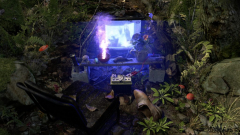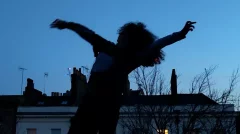VISIO and Rustan Söderling lead us through a landscape of post-apocalyptic mythology, illuminated by fairy light.
VISIO is the enigmatic musical moniker of multidisciplinary artist Nicola Tirabasso, a project devised while on retreat in Sibillini Mountains in Marche, central Italy. Tirabasso describes his latest album, Privacy Angels, as “a liminal zone, a folk magical world sprawling within some remote nodes of the digital universe.” Crafting a rich sonic palette of acoustic instrumentation, intricate sound design and glitched out synthesis, Privacy Angels sounds like folk music broken down and reassembled by algorithm, pitching between the digital and the spiritual, dislocated from place and time yet evocative of a new and distinct vision of the world. Pieced together from recordings made in a desecrated 16th century church near the town of Montappone, the record also invokes the spirit of of abstract painter Osvaldo Licini, who grew up near to Montappone and who’s esoteric approach to painting provides a major inspiration to the world Tirabasso envisions for Privacy Angels. Imagining the end of contemporary civilisation as the means to begin again in a future informed by the mythological past, VISIO has created the soundtrack for a world re-enchanted, where tradition, contemporaneity and futurity drift around each other in esoteric order, moving to a speculative song from a new reality. Following in pursuit of the light of a fairy, artist Rustan Soderling illuminates this mythic place in his response to ‘Youth Grows Forever”, a highlight from the album, in which he picks through the debris of a sunken world, submerged in fading memory.
Set in a similar universe as Russel Hoban’s 1980s science fiction novel Riddley Walker, a stylistic portrait of a new Iron Age occurring two thousand years after a nuclear apocalypse, Youth Grows Forever explores the birth of a new mythology, as the world becomes magical again following the end of civilisation. “In this ‘new iron age,’ humans scavenge iron from the relics of our time,” Tirabasso and Soderling explain. “Trying to understand the past they come up with a new spectacular mythological interpretation of the world. The new language encounters the old language, a new interpretation of the world, the past, the structure of the universe, and the destiny of humans. The long sequence guided by a fairy light slowly moves forward as an act of remembrance, showing constellation of relics of the old world functioning as ignitors of a new cosmology, a new narration of reality, for the people after the end of the new era trying to restart at the intersection of technology, myth-making and magic.” The detritus of incongruous civilisations is strewn across the ground, washed up in this convergence of history and mythology, the broken barrels and upturned pumpkin carts of a fallen agrarian society lying shattered next to a discarded jumper, a still glowing computer monitor, the remnants of domestic technology. Drawn instead to the inscribed signs and eternal sigils of a new myth, our fairy guide leads us past these artefacts towards a magical new present.
Describing the visual as a “folkloristic reimagining and the re-enchantment of the world around us,” Tirabasso and Soderling understand Youth Grows Forever in transformative terms, an exploration of “how to re-world our world in the current moment of political confusion and ecological emergency, to open spaces of possibilities, a new cosmos where whispers of the trees, echoes of the ancestors’ tales, the intuition, the spell and the dream are the crucible of the awakening.” Channeling occult energy from cartomancy and Tarot in the use of esoteric symbolism – numerology, a wheel dripping with candle wax, a hanged man blooming with flowers – Soderling reflects VISIO’s hybrid musical practice of breaking and remaking with gradual semiotic deconstruction, objects lifted from primitive civilisations giving way first to signs of the contemporary and then to mythic symbols, eventually entering into the fairy’s light to search of a new physical order, constructed from fragments of the old. “From water, to mud into the cornfield and the hanged man at the end of the journey, brings light at the end of the path, the ultimate surrender embodying new insights, awareness and enlightenment leaving traces and relics behind,” conclude Tirabasso and Soderling. “We forget in order to remember.”
‘Youth Grows Forever’ is taken from P





